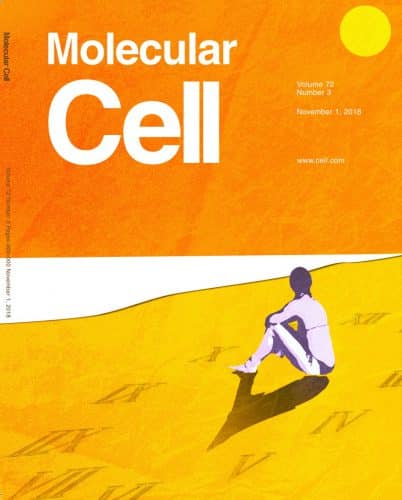Scientists from Tel Aviv University and the Technion discovered a 48-hour cycle process that synchronizes the defense mechanisms that arise in the skin after exposure to UV rays * The study was published yesterday 25.10.18 in the journal Molecular Cell, which even dedicated the cover page to it

Scientists at Tel Aviv University, led by Prof. Carmit Levy and doctoral student Hagar Malkov from the Department of Human Genetics and Biochemistry at the Faculty of Medicine, have identified a process that synchronizes the skin's natural defense mechanisms. It is a cyclical process that spreads through the skin in the form of a wave for 48 hours after exposure to ultraviolet rays. The researchers found that exposure to the sun as often as once every two days leads to optimal operation of the mechanism and optimal tanning.
Researchers Prof. Shai Shen-Or and PhD student Ayelet Alpert from the Rappaport Faculty of Medicine at the Technion and Dr. Medi Cald from Gustavo-Rossi in France participated in the study. The article was published on October 25.10.18, XNUMX in the journal Molecular Cell, which even dedicated the cover page to it (see photo).
"During evolution, when man lost the fur that protected his skin, our skin developed natural defense mechanisms that arise following exposure to the sun's rays," explains Prof. Levy. "One of them is the mechanism of pigmentation, or tanning, which creates physical-mechanical protection for the skin. Another mechanism mobilizes the immune system to repair DNA damage caused by UV radiation and can cause the development of skin cancer."
Many scientists in the world study the effect of the sun's rays on our skin, but according to Prof. Levy, most studies focus on reactions related to the intensity of exposure. The researchers at Tel Aviv University, on the other hand, examined the influence of another factor: frequency. To this end, they exposed samples of human skin to UV rays at a constant intensity - at the level of summer sun at midday - but at different frequencies: every day, once every two days, intermittent exposure, etc. "To our surprise, we discovered that exposure once every two days, rather than daily exposure, results in optimal tanning," says Prof. Levy. "In fact, we showed that the frequency of exposure is very important, and we looked for an explanation for the phenomenon."
The researchers in Prof. Levy's laboratory sampled the skin every hour after exposure and collected diverse data on the response of the defense systems to exposure at different frequencies. Among other things, they measured levels of different proteins
In the skin, pigmentation levels, RNA and DNA repair. They discovered that proteins that express certain genes appear in the skin in an orderly and well-synchronized sequence during the 48 hours after exposure to UV radiation.
To deepen the understanding of the processes, the researchers from Tel Aviv teamed up with Associate Professor Shai Shen-Or from the Rapaport Faculty of Medicine at the Technion. Prof. Shen-Or and student Eilat Alpert built a mathematical model that showed that the levels of the protein MITF, responsible for the skin's defense mechanisms, rise and fall in the skin in the form of a wave that fades over time, thereby activating the defense mechanisms in a synchronized manner. Since the propagation of the wave takes 48 hours, further exposure during this time period disrupts its activity. "Imagine that you threw a stone into a lake, and it created spreading circles of waves," explains Prof. Shen-Or. "If you throw another stone before the first wave has died down, the wave created by the second stone will disrupt the propagation of the first wave. This is exactly what happens in the skin. Additional exposure to the sun during the activity of the first synchronization wave reduces the effectiveness of the skin protection systems."
The mathematical model was verified experimentally in the laboratory.
"We discovered that the biological cycle of the skin's defense mechanisms is 48 hours, and this is in contrast to the natural exposure to the sun that occurs every day, that is, in a 24-hour cycle," Prof. Levy concludes. "Now we are trying to understand the reason for this. It may be related to the expression of vitamin D, which is related to sun exposure and reaches its peak every 48 hours. In any case, we recommend to everyone that in order to achieve optimal protection after exposure to the sun, let the natural mechanism in your skin complete its action and do not increase exposure to the sun with high frequency."

One response
The optimal uniform tanning (without freckles) is the one performed with rays with not too high intensity for short periods of time. This is the only way the skin gets a dark shade and it will be more resistant to rays with higher intensity. The science of weather forecasting has not yet discovered what strong radiation and weak radiation are for tanning, since the weather forecast tells you temperature and UV radiation in a very general way. Usually up to 32 degrees on the same day, this is reasonable radiation every hour for short periods of time and above it causes immediate damage. But not always. Sometimes even 32 will do damage. Sometimes even over 32 won't do any harm if it's cloudy. There should be a measure of skin pigment against actual UV radiation that also includes cloud filters.